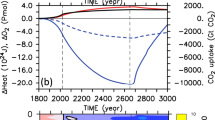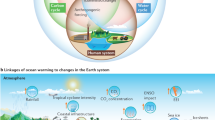Abstract
Ongoing global warming could persist far into the future, because natural processes require decades to hundreds of thousands of years to remove carbon dioxide from fossil-fuel burning from the atmosphere1,2,3. Future warming may have large global impacts including ocean oxygen depletion and associated adverse effects on marine life, such as more frequent mortality events4,5,6,7,8, but long, comprehensive simulations of these impacts are currently not available. Here we project global change over the next 100,000 years using a low-resolution Earth system model9, and find severe, long-term ocean oxygen depletion, as well as a great expansion of ocean oxygen-minimum zones for scenarios with high emissions or high climate sensitivity. We find that climate feedbacks within the Earth system amplify the strength and duration of global warming, ocean heating and oxygen depletion. Decreased oxygen solubility from surface-layer warming accounts for most of the enhanced oxygen depletion in the upper 500 m of the ocean. Possible weakening of ocean overturning and convection lead to further oxygen depletion, also in the deep ocean. We conclude that substantial reductions in fossil-fuel use over the next few generations are needed if extensive ocean oxygen depletion for thousands of years is to be avoided.
This is a preview of subscription content, access via your institution
Access options
Subscribe to this journal
Receive 12 print issues and online access
$259.00 per year
only $21.58 per issue
Buy this article
- Purchase on Springer Link
- Instant access to full article PDF
Prices may be subject to local taxes which are calculated during checkout


Similar content being viewed by others
References
Archer, D. Fate of fossil fuel CO2 in geologic time. J. Geophys. Res. 110, C09S05 (2005).
Sundqvist, E. T. Steady- and non-steady carbonate-silicate controls on atmospheric CO2 . Quat. Sci. Rev. 10, 283–296 (1991).
Lenton, T.M. & Britton, C. Enhanced carbonate and silicate weathering accelerates recovery from fossil fuel CO2 perturbation. Glob. Biogeochem. Cycles 20, GB3009 (2006).
Matear, R. J. & Hirst, A. C. Long-term changes in dissolved oxygen concentrations in the ocean caused by protracted global warming. Glob. Biogeochem. Cycles 17, GB1125 (2003).
Schmittner, A., Oschlies, A., Matthews, H. D. & Galbraith, E. D. Future changes in climate, ocean circulation, ecosystems, and biogeochemical cycling simulated for a business-as-usual CO2 emission scenario until AD 4000. Glob. Biogeochem. Cycles 22, GB1013 (2008).
Gray, J. S., Wu, R. S. & Or, Y. Y. Effects of hypoxia and organic enrichment on the coastal marine environment. Mar. Ecol. Prog. Ser. 238, 249–279 (2002).
Grantham, B. A. et al. Upwelling-driven nearshore hypoxia signals ecosystem and oceanographic changes in the northeast Pacific. Nature 429, 749–754 (2004).
White, R. V. Earth’s biggest whodunit: Unraveling the clues in the case of the end-Permian mass extinction. Phil. Trans. R. Soc. Lond. A 360, 2963–2985 (2002).
Shaffer, G., Olsen, S. M. & Pedersen, J. O. P. Presentation, calibration and validation of the low-order, DCESS Earth System model. Geosci. Model Dev. 1, 17–51 (2008).
IPCC, in Contribution of Working Group I to the Fourth Assessment Report of the Intergovernmental Panel on Climate Change (eds Solomon, S. D. et al.) 996 (Cambridge Univ. Press, 2007).
Crowley, T. J. Causes of climate change over the past 1000 years. Science 289, 270–277 (2000).
Marland, G., Boden, T. A. & Andres, R. J. Trends: A Compendium of Data on Global Change (Carbon Dioxide Information Analysis Center, Oak Ridge National Laboratory, US Department of Energy, 2007).
Houghton, R. A. Magnitude, distribution and causes of terrestrial carbon sinks and some implications for policy. Clim. Policy 2, 71–88 (2002).
Stern, D. I. & Kaufmann, R. K. Trends: A Compendium of Data on Global Change (Carbon Dioxide Information Analysis Center, Oak Ridge National Laboratory, US Department of Energy, 1998).
Nakićenović, N. & Swart, R. (eds) A Special Report of Working Group III of the Intergovernmental Panel on Climate Change 599 (Cambridge Univ. Press, 2000).
Friedlingstein, P. et al. Climate-carbon cycle feedback analysis: Results from the C4MIP model intercomparison. J. Clim. 19, 3337–3353 (2006).
Archer, D. & Buffett, B. Time-dependent response of the global ocean clathrate reservoir to climatic and anthropogenic forcing. Geochem. Geophys. Geosyst. 6, Q03002 (2005).
Bange, H. W., Naqvi, S. W. & Codispoti, L. A. The nitrogen cycle in the Arabian Sea. Prog. Oceanogr. 65, 145–158 (2005).
Garcia, H. E., Locarnini, R. A., Boyer, T. P. & Antonov, J. I. in World Ocean Atlas 2005 Vol. 3 (ed. Levitus, S.) 342 (NOAA Atlas NESDIS 63, US Government Printing Office, 2006).
Huang, R. X. & Qiu, B. The structure of the wind-driven circulation in the subtropical South Pacific Ocean. J. Phys. Oceanogr. 28, 1173–1186 (1998).
Stramma, L., Johnson, G. C., Sprintall, J. & Mohrholz, V. Expanding oxygen-minimum zones in the tropical oceans. Science 320, 655–658 (2008).
Gregory, J. M. et al. A model intercomparison of changes in the Atlantic thermohaline circulation in response to increasing atmospheric CO2 concentration. Geophys. Res. Lett. 32, L12704 (2005).
Toggweiler, J. R. & Russell, J. Ocean circulation in a warming climate. Nature 451, 286–288 (2008).
Keeling, R. F. & Garcia, H. E. The change in oceanic oxygen inventory associated with recent global warming. Proc. Natl Acad. Sci. 99, 7848–7853 (2002).
Deutsch, C., Sarmiento, J. L., Sigman, D. M., Gruber, N. & Dunne, J. P. Spatial coupling of nitrogen inputs and losses in the ocean. Nature 445, 163–167 (2007).
Loutre, M. F. & Berger, A. Future climatic changes: Are we entering an exceptionally long interglacial? Clim. Change 46, 61–90 (2000).
IPCC, in Contribution of Working Group I to the Third Assessment Report of the Intergovernmental Panel on Climate Change (eds Houghton, J. T. et al.) 881 (Cambridge Univ. Press, 2001).
Andreae, M. O., Jones, C. D. & Cox, P. M. Strong present-day aerosol forcing implies a hot future. Nature 435, 1187–1190 (2005).
Hansen, J. & Sato, M. Forcings in GISS climate model: Well-mixed anthropogenic greenhouse gases. <http://data.giss.nasa.gov/modelforce/ghgases> (2007).
Jones, P. D., Parker, D. E., Osborn, T. J. & Briffa, K. R. Trends: A Compendium of Data on Global Change (Carbon Dioxide Information Analysis Center, Oak Ridge National Laboratory, US Department of Energy, 2006).
Acknowledgements
Partial support for G.S. was supplied by the Danish Natural Science Research Foundation and by CONICYT-Chile through grant PBCT-Anillo ACT-19.
Author information
Authors and Affiliations
Contributions
G.S. planned the research and designed model experiments of projected change. G.S., S.M.O. and J.O.P.P. conducted the experiments, wrote the paper and prepared the graphics.
Corresponding author
Supplementary information
Supplementary Information, Fig. S1
Supplementary Information (PDF 998 kb)
Rights and permissions
About this article
Cite this article
Shaffer, G., Olsen, S. & Pedersen, J. Long-term ocean oxygen depletion in response to carbon dioxide emissions from fossil fuels. Nature Geosci 2, 105–109 (2009). https://doi.org/10.1038/ngeo420
Received:
Accepted:
Published:
Issue Date:
DOI: https://doi.org/10.1038/ngeo420
This article is cited by
-
van der Waals type II carbon nitride homojunctions for visible light photocatalytic hydrogen evolution
Nano Research (2023)
-
The oxygen cycle and a habitable Earth
Science China Earth Sciences (2021)
-
Ocean acidification promotes broad transcriptomic responses in marine metazoans: a literature survey
Frontiers in Zoology (2020)
-
Loss of fixed nitrogen causes net oxygen gain in a warmer future ocean
Nature Communications (2019)
-
Review: The projected hydrologic cycle under the scenario of 936 ppm CO2 in 2100
Hydrogeology Journal (2019)



